Deza M.M., Laurent M. Geometry of Cuts and Metrics
Подождите немного. Документ загружается.

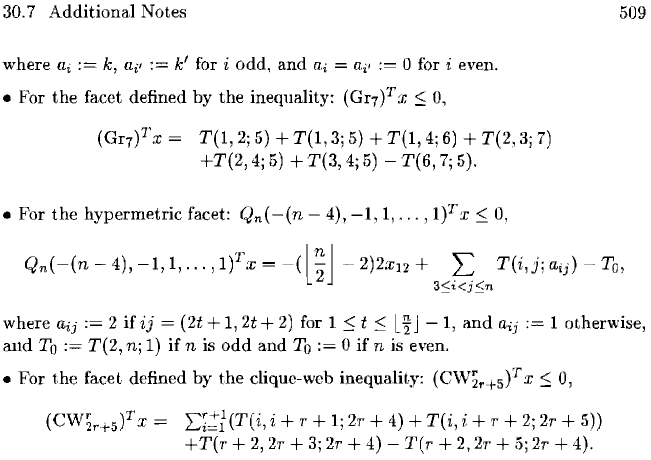
30.7 Additional Notes
where
ai
:=
k, ai'
:=
k' for i odd,
and
ai ai' ° for i even.
• For
the
facet defined by
the
inequality: (Gr7 f x
::;
0,
(Gr7
)T.
r =
T(l,
2;
5)
+
T(l,
3;
5)
+
T(l,
4;
6)
+
T(2,
3;
7)
+T(2,
4;
5)
+
T(3,
4;
5)
T(6,
7;
5).
• For
the
hypermetric
facet: Qn(
-(n
4),
T
lnJ
Qn(-(n-4),-1,1,
...
,1)
x=-("2
509
where
aij
:=
2
if
ij
= (2t + 1,
2t
+
2)
for 1
::;
t
::;
L
~
J 1,
and
aij
1 otherwise,
and
To
:=
T(2,
nj 1)
if
n is
odd
and
To
:=
°
if
n is even.
•
For
the
facet defined
by
the
clique-web inequality: (CW
2r
+5f
x
::;
0,
(CW2r+5f
x = 2:I;;;t(T(i, i + r +
1;
2r +
4)
+
T(i,
i + r + 2; 2r + 5))
+T(r
+ 2, 2r +
3;
2r + 4) -
T(r
+ 2, 2r +
5;
2r + 4).
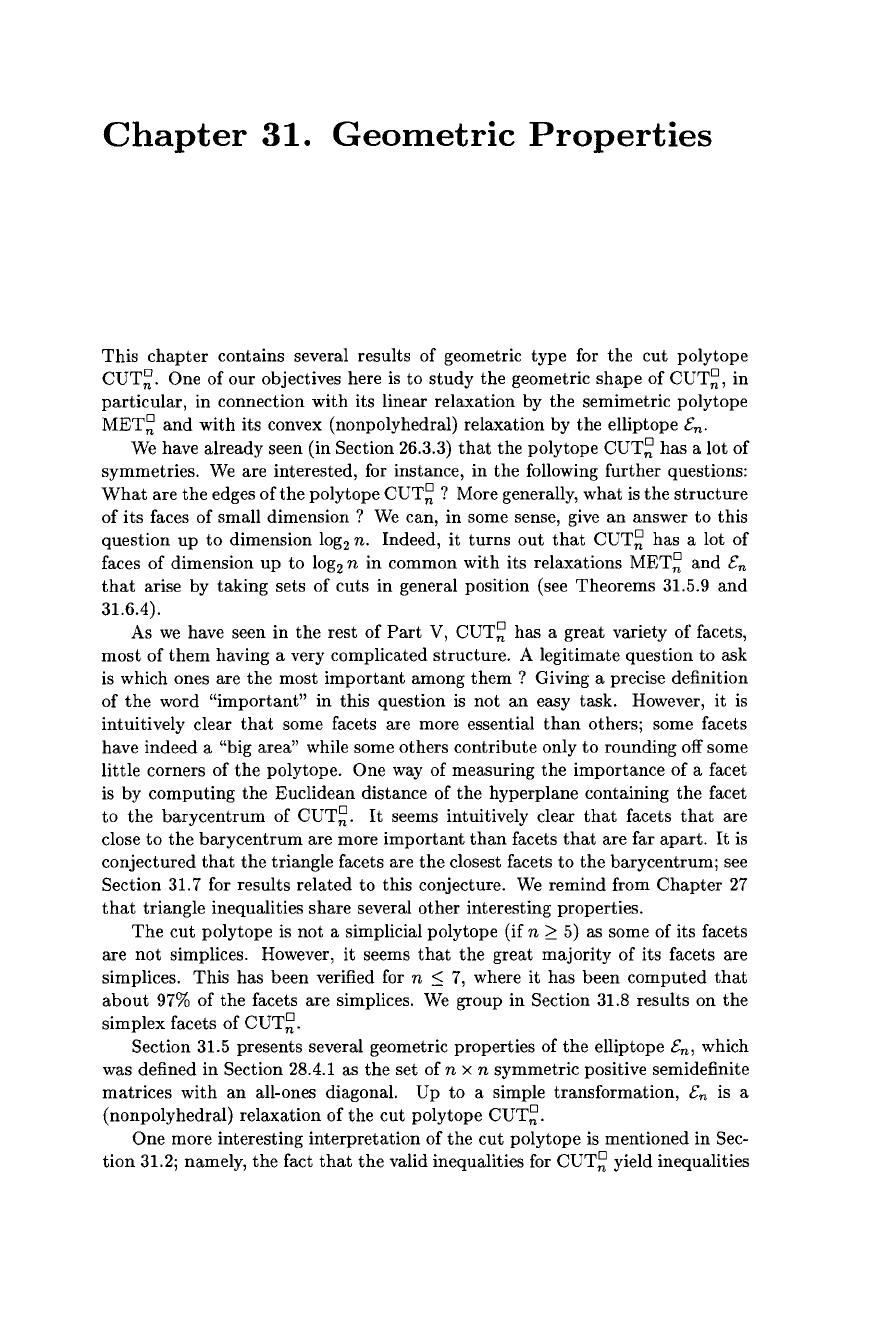
M.M. Deza, M. Laurent, Geometry of Cuts and Metrics, Algorithms and Combinatorics 15,
DOI 10.1007/978-3-642-04295-9_31, © Springer-Verlag Berlin Heidelberg 2010
Chapter
31.
Geometric
Properties
This
chapter
contains several results
of
geometric
type
for
the
cut
polytope
CUT~.
One
of
our
objectives here is
to
study
the
geometric
shape
of
CUT~,
in
particular,
in connection
with
its linear relaxation by
the
semimetric polytope
MET~
and
with
its
convex (nonpolyhedral) relaxation by
the
elliptope
En.
We have already seen (in Section 26.3.3)
that
the
polytope
CUT~
has
a lot
of
symmetries.
We
are interested, for instance,
in
the
following further questions:
What
are
the
edges
ofthe
polytope
CUT~
? More generally,
what
is
the
structure
of
its
faces
of
small
dimension?
We
can,
in
some sense, give
an
answer
to
this
question
up
to
dimension
10g2
n. Indeed,
it
turns
out
that
CUT~
has a lot
of
faces
of
dimension
up
to
10g2
n
in
common
with
its
relaxations
MET~
and
En
that
arise by
taking
sets
of
cuts
in
general position (see Theorems 31.5.9
and
31.6.4).
As
we
have seen
in
the
rest
of
Part
V,
CUT~
has a
great
variety
of
facets,
most
of
them
having a very complicated
structure.
A legitimate question to ask
is which ones are
the
most
important
among
them?
Giving a precise definition
of
the
word
"important"
in
this question
is
not
an
easy task. However,
it
is
intuitively clear
that
some facets are more essential
than
others; some facets
have indeed a "big area" while some others
contribute
only
to
rounding off some
little corners
of
the
polytope. One way of measuring
the
importance
of
a facet
is by
computing
the
Euclidean distance of
the
hyperplane containing
the
facet
to
the
barycentrum
of
CUT~.
It
seems intuitively clear
that
facets
that
are
close
to
the
barycentrum
are more
important
than
facets
that
are far
apart.
It
is
conjectured
that
the
triangle facets are
the
closest facets
to
the
barycentrum;
see
Section
31. 7 for results related to this conjecture. We
remind
from
Chapter
27
that
triangle inequalities share several
other
interesting properties.
The
cut
polytope
is not a simplicial polytope (if n
2:
5) as some of its facets
are
not
simplices. However,
it
seems
that
the
great
majority
of
its facets are
simplices.
This
has
been
verified for n
::;
7,
where
it
has
been
computed
that
about
97%
of
the
facets are simplices. We group
in
Section 31.8 results on
the
simplex facets
of
CUT~.
Section 31.5 presents several geometric properties of
the
elliptope
En,
which
was defined
in
Section 28.4.1 as
the
set of n x n
symmetric
positive semidefinite
matrices
with
an
all-ones diagonal. Up
to
a simple
transformation,
En
is a
(nonpolyhedral) relaxation
of
the
cut
polytope
CUT~.
One
more interesting
interpretation
of
the
cut
polytope is mentioned
in
Sec-
tion
31.2; namely,
the
fact
that
the
valid inequalities for
CUT~
yield inequalities
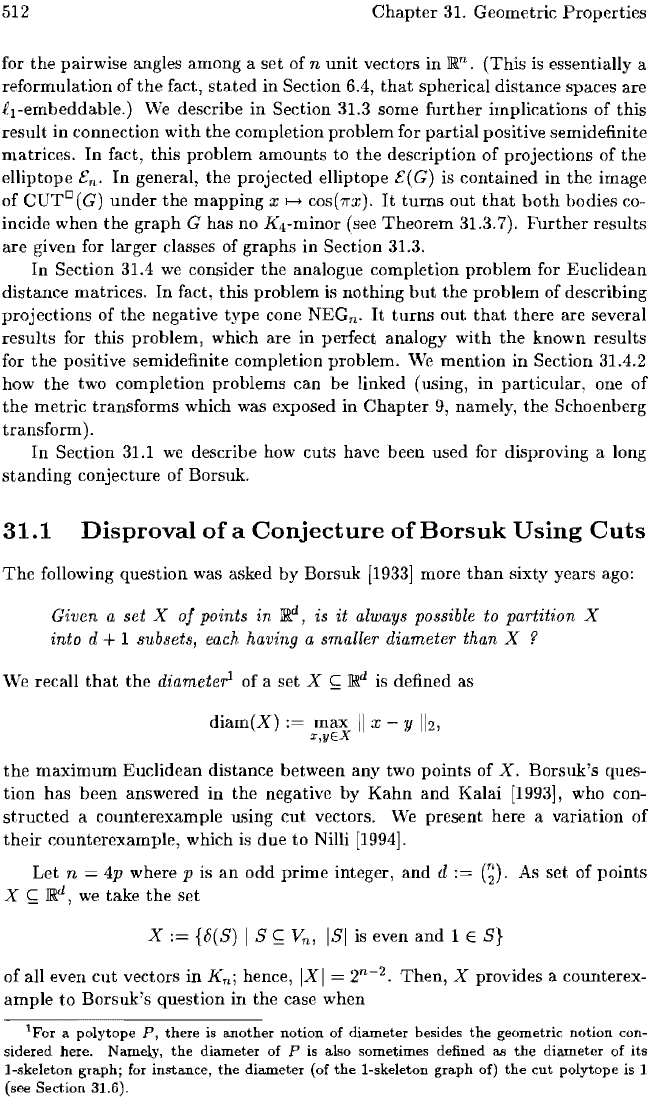
512
Chapter
31. Geometric
Properties
for
the
pairwise angles among a set of n unit vectors in llln. (This is essentially a
reformulation of
the
fact,
stated
in Section 6.4,
that
spherical distance spaces are
{l-embeddable.)
We
describe in Section 31.3 some further implications of this
result in connection
with
the
completion problem for
partial
positive semidefinite
matrices. In fact, this problem amounts to
the
description of projections of
the
elliptope
En.
In
general,
the
projected elliptope
E(
G) is contained in
the
image
of CUTO(G)
under
the
mapping x
1-+
cos(7T'x).
It
turns
out
that
both
bodies co-
incide when
the
graph
G has no K
4
-minor (see Theorem 31.3.7).
Further
results
are given for larger classes of graphs in Section 31.3.
In
Section 31.4
we
consider
the
analogue completion problem for Euclidean
distance matrices.
In
fact, this problem is nothing
but
the
problem of describing
projections of the negative
type
cone NEG
n
•
It
turns
out
that
there are several
results for
this
problem, which are
in
analogy
with
the
known results
for
the
positive semidefinite completion problem. We mention in Section 31.4.2
how
the
two completion problems
can
be
linked (using, in particular, one
of
the
metric transforms which was exposed in
Chapter
9,
namely,
the
Schoenberg
transform).
In
Section 31.1
we
describe how cuts have been used for disproving a long
standing
conjecture of Borsuk.
31.1
Disproval
ofa
Conjecture
of
Borsuk
Using
Cuts
The
following question was asked by Borsuk
[1933]
more
than
sixty years ago:
Given a set X
of
points
in
llR.
d
,
is it always possible to partition X
into d
+ 1 subsets, each having a smaller diameter than X ?
We recall
that
the
diameterI of a set X
5;;
llld
is defined as
diam(X)
max
II
x - y
112,
x,yEX
the
maximum
Euclidean distance between any two points of
X.
Borsuk's ques-
tion
has
been
answered in
the
negative by
Kahn
and
Kalai [1993], who con-
structed
a counterexample using
cut
vectors.
We
present here a variation of
their
counterexample, which
is
due
to Nilli [1994].
Let n
4p where p is
an
odd prime integer,
and
d
:=
(~).
As
set of points
X
5;;
llld,
we
take
the
set
X:=
{tiCS)
IS
5;;
V
n
,
lSI
is even
and
1 E S}
of all even
cut
vectors in
Kn;
hence,
IXI
=
2n-2.
Then,
X provides a counterex-
ample
to
Borsuk's question
in
the case when
a
polytope
P,
there
is
another
notion
of
diameter
besides
the
geometric
notion
con-
sidered
here. Namely,
the
diameter
of
P is also sometimes defined as
the
diameter
of
its
l-skeleton
graph;
for
instance,
the
diameter
(of
the
l-skeleton
graph
of)
the
cut
polytope
is 1
(see Section 31.6).
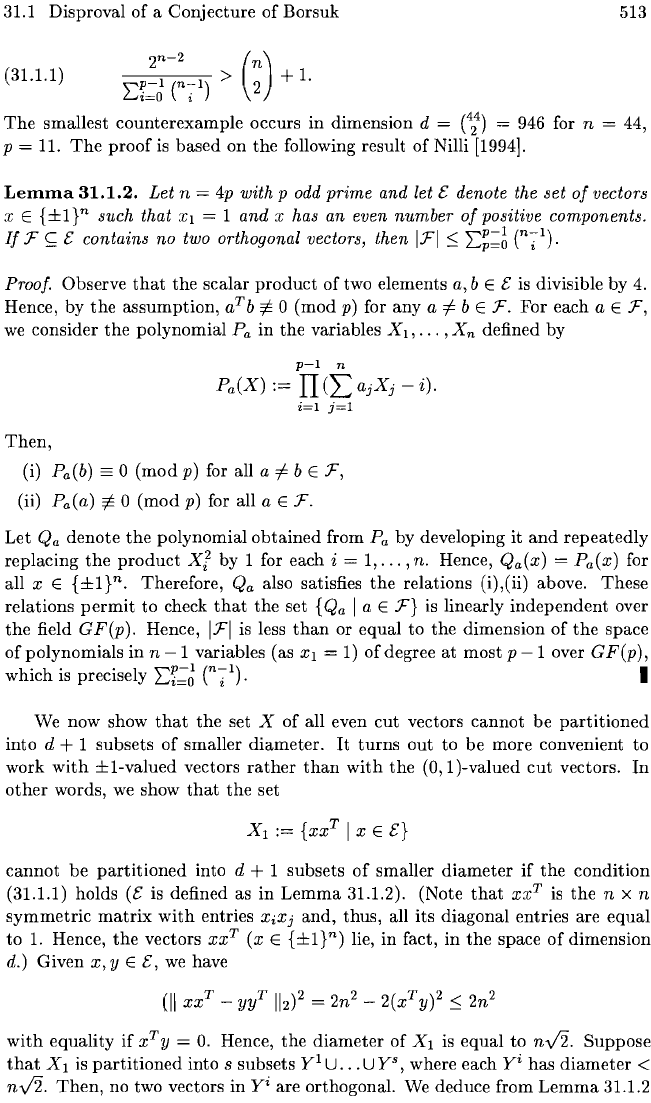
31.1 Disproval
of
a
Conjecture
of
Borsuk
513
(31.1.1)
~f~;~:il)
>
(;)
+
1.
The
smallest
counterexample
occurs
in
dimension
d =
(4i)
= 946 for n = 44,
p = 11.
The
proof
is
based
on
the
following result
of
Nilli [1994].
Lemma
31.1.2.
Let
n = 4p with p odd
prime
and
let
t:
denote the
set
of
vectors
x
E
{±I}n
such
that
Xl
= 1
and
X has an even
number
of
positive components.
If
F
~
t:
contains
no
two orthogonal vectors,
then
IFI
::;
~~;;:~
(nil).
Proof. Observe
that
the
scalar
product
of
two elements a,
bEt:
is divisible by 4.
Hence, by
the
assumption,
aTb
=f=
0
(mod
p)
for
any
a
=1=
b E
F.
For
each a E
F,
we
consider
the
polynomial
P
a
in
the
variables
Xl,
...
,X
n
defined by
p-l
n
Pa(X)
:=
II
(2:
ajXj
- i).
i=l
j=l
Then,
(i) Pa(b)
==
0
(mod
p)
for all a
=1=
b E
F,
(ii) Pa(a)
=f=
0
(mod
p)
for all a E
F.
Let
Qa
denote
the
polynomial
obtained
from P
a
by developing
it
and
repeatedly
replacing
the
product
xl
by 1 for each i = 1,
...
,no Hence, Qa(x) = Pa(x) for
all
x E
{±I}n.
Therefore,
Qa
also satisfies
the
relations (i),(ii) above.
These
relations
permit
to
check
that
the
set {Qa I a E
F}
is linearly
independent
over
the
field G F(p). Hence,
IFI
is less
than
or
equal
to
the
dimension
of
the
space
of
polynomials
in
n
-1
variables (as
Xl
= 1)
of
degree
at
most
p
-1
over GF(p),
which
is precisely
~f~~
(nil). I
We now show
that
the
set X
of
all even
cut
vectors
cannot
be
partitioned
into
d + 1
subsets
of
smaller
diameter.
It
turns
out
to
be
more
convenient
to
work
with
±1-valued
vectors
rather
than
with
the
(0,
I)-valued
cut
vectors.
In
other
words,
we
show
that
the
set
cannot
be
partitioned
into d + 1
subsets
of
smaller
diameter
if
the
condition
(31.1.1) holds (t: is defined as
in
Lemma
31.1.2). (Note
that
xx
T
is
the
n x n
symmetric
matrix
with
entries
XiXj
and,
thus,
all
its
diagonal
entries are
equal
to
1.
Hence,
the
vectors
xxT
(x E
{±I}n)
lie,
in
fact,
in
the
space
of
dimension
d.)
Given
X,y
E t:,
we
have
with
equality
if
x
T
y =
O.
Hence,
the
diameter
of
Xl
is
equal
to
nV2.
Suppose
that
Xl
is
partitioned
into s
subsets
yl
U
...
Uys,
where each
yi
has
diameter
<
nV2.
Then,
no two vectors
in
yi
are orthogonal. We
deduce
from
Lemma
31.1.2
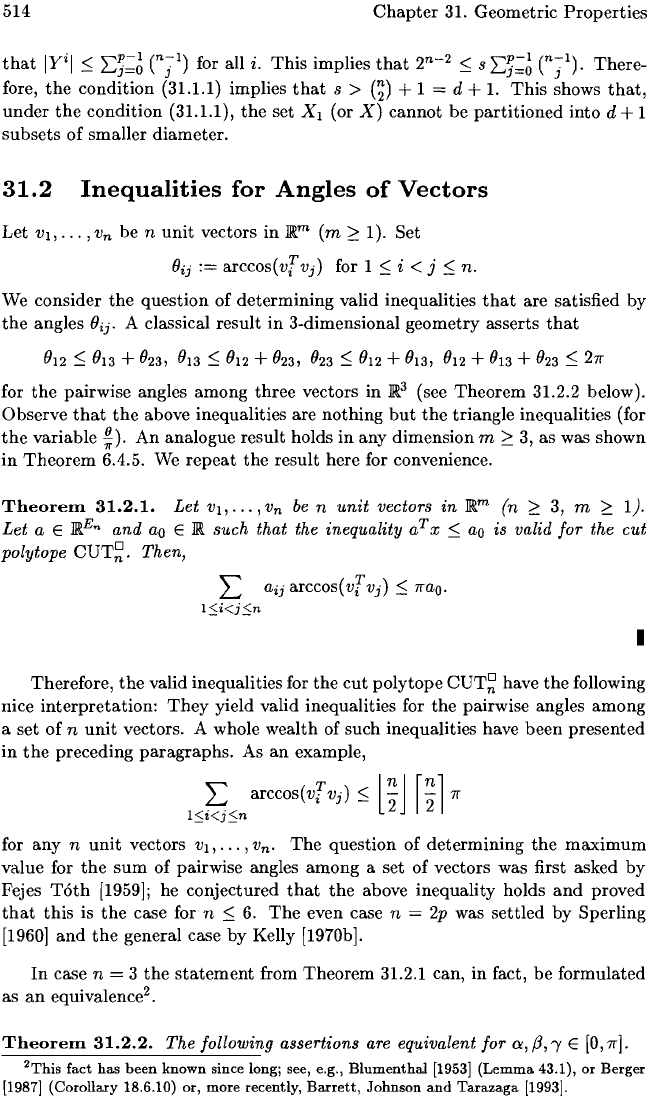
514
Chapter
31. Geometric
Properties
that
Iyil
::;
2:~:6
(njl)
for all i.
This
implies
that
2
n
-
2
::;
s
2:~:6
(njl).
There-
fore,
the
condition (31.1.1) implies
that
s >
G)
+ 1 = d +
1.
This
shows
that,
under
the
condition (31.1.1),
the
set
XI
(or
X)
cannot be
partitioned
into d + 1
subsets
of
smaller diameter.
31.2
Inequalities
for
Angles
of
Vectors
Let
VI,
•..
,
Vn
be n
unit
vectors
in
JRm
(m
:::0:
1). Set
()ij
:=
arccos(vT Vj) for 1
::;
i < j
::;
n.
We
consider
the
question of determining valid inequalities
that
are satisfied by
the
angles ()ij. A classical result
in
3-dimensional geometry asserts
that
()12 ::; ()13 + ()23, ()13 ::; ()12 + ()23, ()23 ::; ()12 + ()13, ()12 + ()13 + ()23 ::;
27r
for
the
pairwise angles among three vectors
in
JR3
(see
Theorem
31.2.2 below).
Observe
that
the
above inequalities are nothing
but
the
triangle inequalities (for
the
variable
*).
An
analogue result holds
in
any dimension m
:::0:
3, as was shown
in
Theorem
6.4.5.
We
repeat
the
result here for convenience.
Theorem
31.2.1.
Let
VI,
...
,Vn
be
n
unit
vectors
in]Rm
(n
:::0:
3,
m
:::0:
1).
Let
a E
JRE
n
and
ao
E
JR
such
that
the inequality
aT
x
::;
ao
is valid
for
the
cut
polytope
CUT~.
Then,
L aij arccos (
vT
Vj)
::;
7rao·
l::;i<j$n
I
Therefore,
the
valid inequalities for
the
cut
polytope
CUT~
have
the
following
nice interpretation:
They
yield valid inequalities for
the
pairwise angles among
a set
of
n
unit
vectors. A whole wealth of such inequalities have been presented
in
the
preceding
paragraphs.
As
an
example,
L arccos (
vT
Vj)
::;
l::J
f::l7r
l$i<j$n
2 2
for any n
unit
vectors
VI,
...
, V
n
.
The
question of determining
the
maximum
value for
the
sum
of pairwise angles among a set of vectors was first asked
by
Fejes
T6th
[1959]; he conjectured
that
the
above inequality holds
and
proved
that
this
is
the
case for n
::;
6.
The
even case n =
2p
was settled by Sperling
[1960]
and
the
general case by Kelly [1970b].
In
case n = 3
the
statement
from
Theorem
31.2.1 can,
in
fact,
be
formulated
as
an
equivalence
2
•
Theorem
31.2.2.
The
following
assertions
are equivalent
for
a,;3,
IE
[0,7r].
2This fact
has
been
known since long; see, e.g.,
Blumenthal
[1953]
(Lemma
43.1),
or
Berger
[1987] (Corollary 18.6.10) or,
more
recently,
Barrett,
Johnson
and
Tarazaga
[1993].
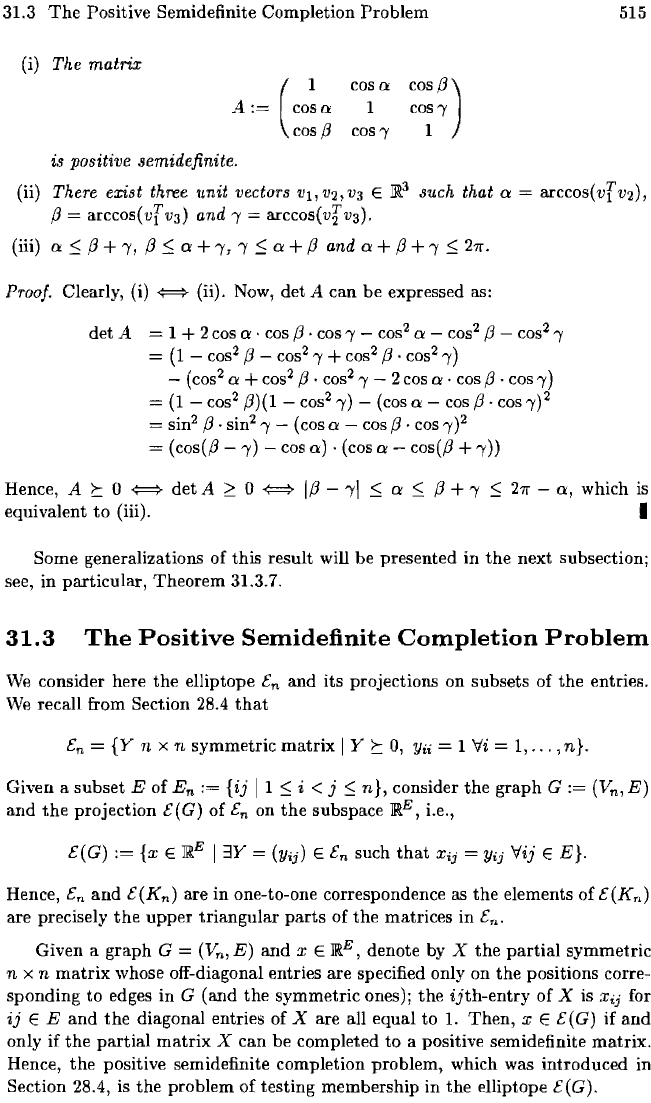
31.3
The
Positive Semidefinite Completion
Problem
515
(i)
The matrix
is positive semidefinite.
(ii) There exist three unit vectors
vb
V2,
va
E
IR3
such that 0 = arccos(
v[
V2),
fJ
= arccos(v[V3)
and,
arccos(vfva).
(iii) 0
~
fJ
+"
fJ
~
0 + " ,
~
0 +
fJ
and 0 +
fJ
+,
::;
21f.
Proof. Clearly, (i)
¢::::>
(ii). Now,
det
A
can
be
expressed as:
det
A = 1 +
2coso·
cos
fJ·
cos,
cos
2
o cos
2
fJ
- cos
2
,
=
(1
- cos
2
fJ
- cos
2
,
+ cos
2
fJ·
cos
2
,)
- (cos
2
o + cos
2
fJ
. cos
2
,
2 cos
o·
cos
fJ·
cos,)
=
(1
- cos
2
(J)(1
- cos
2
,)
(cos 0 - cos
fJ·
cos
,)2
= sin
2
fJ·
sin
2
,
(cos 0 cos
fJ·
cos
,)2
= (cos(fJ -
,)
cos
0)
. (cos 0 cos(fJ + ,))
Hence, A
to¢::::>
det
A
~
0
¢::::>
IfJ
equivalent
to
(iii).
,I
~
0
::;
fJ
+,
::;
21f
-
0,
which is
I
Some generalizations
of
this
result will be presented
in
the
next subsection;
see, in
particular,
Theorem
31.3.7.
31.3
The
Positive
Semidefinite
Completion
Problem
We
consider here
the
elliptope
En
and
its projections
on
subsets
of
the
entries.
We
recall from Section 28.4
that
En
{Y
n X n
symmetric
matrix
I Y t 0,
Yii
= 1
Vi
= 1,
...
,n}.
Given a
subset
E
of
En
:=
{ij
11
::;
i < j
::;
n},
consider
the
graph
G
(Vn,
E)
and
the
projection E(G)
of
En
on
the
subspace
IRE,
Le.,
E(G)
{x
E
IRE
13Y = (Yij) E
En
such
that
Xij
=
Yij
Vij E
E}.
Hence,
En
and
E(Kn) are
in
one-to-one correspondence as
the
elements
of
E(K
n
}
are precisely
the
upper
triangular
parts
of
the
matrices in
En.
Given a
graph
G (Vn'
E)
and
x E
IRE,
denote by X
the
partial
symmetric
n x n
matrix
whose off-diagonal entries are specified only on
the
positions corre-
sponding
to
edges in G
(and
the
symmetric
ones);
the
ijth-entry
of
X is
Xij
for
ij
E E
and
the
diagonal entries
of
X are all equal
to
1.
Then,
x E E(G)
if
and
only if
the
partial
matrix
X
can
be completed
to
a positive semidefinite
matrix.
Hence,
the
positive semidefinite completion problem, which was introduced in
Section 28.4, is the
problem
of
testing
membership in
the
elliptope E(G).
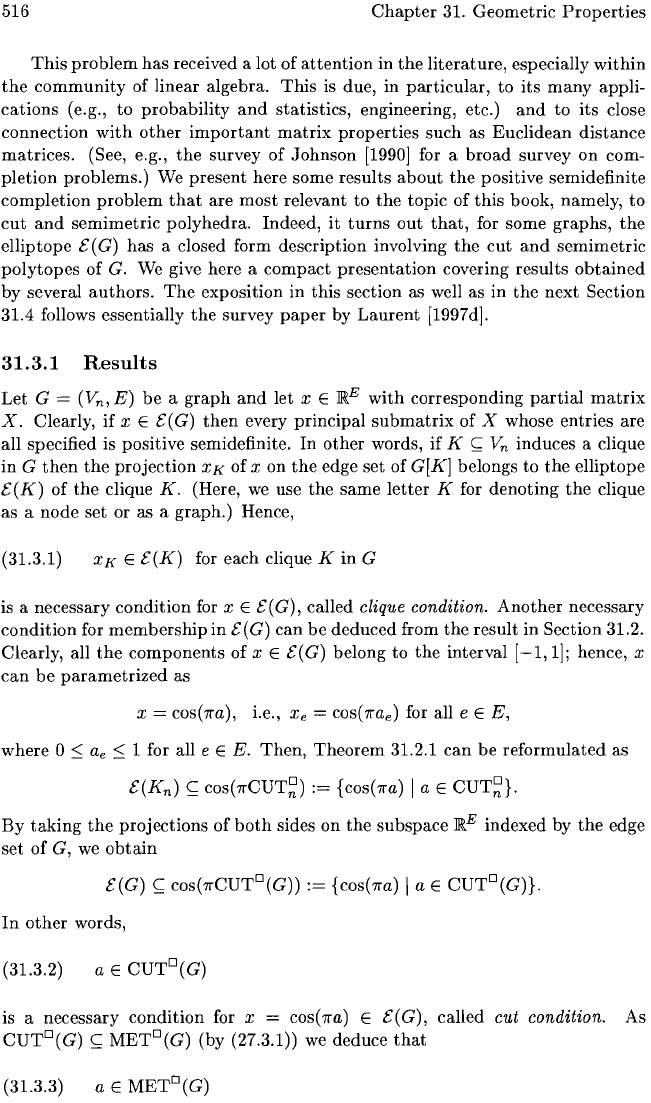
516
Chapter
31. Geometric
Properties
This
problem
has
received a lot of
attention
in
the
literature, especially
within
the
community
of linear algebra.
This
is
due, in
particular,
to
its
many
appli-
cations
(e.g., to
probability
and
statistics, engineering, etc.)
and
to
its
close
connection
with
other
important
matrix
properties
such as Euclidean
distance
matrices. (See, e.g.,
the
survey of Johnson
[1990]
for a
broad
survey
on
com-
pletion problems.) We present here some results
about
the
positive semidefinite
completion
problem
that
are
most
relevant to
the
topic of
this
book, namely, to
cut
and
semimetric
polyhedra. Indeed,
it
turns
out
that,
for some graphs,
the
elliptope E(G) has a closed form description involving
the
cut
and
semimetric
polytopes
of G. We give here a
compact
presentation
covering results
obtained
by several
authors.
The
exposition in
this
section as well as in
the
next Section
31.4 follows essentially
the
survey
paper
by
Laurent
[1997 d].
31.3.1
Results
Let G = (Vn'
E)
be
a
graph
and
let x E
JW.E
with
corresponding
partial
matrix
X.
Clearly, if x E E(G)
then
every principal
submatrix
of X whose entries are
all specified is positive semidefinite.
In
other
words, if K
<;;;
Vn
induces a clique
in
G
then
the
projection
XK
of x on
the
edge set of G[K] belongs to
the
elliptope
E(K)
of
the
clique
K.
(Here,
we
use
the
same
letter
K for denoting
the
clique
as a node set or as a graph.) Hence,
(31.3.1)
XK
E E(K) for each clique K
in
G
is a necessary condition for
x E E(G), called clique condition.
Another
necessary
condition for
membership
in
E(
G) can
be
deduced from
the
result in Section 31.2.
Clearly, all
the
components
of x E E(G) belong to
the
interval
[-1,1];
hence, x
can
be
parametrized
as
x = cos(7ra), i.e.,
Xe
= cos(7ra
e
)
for all e E
E,
where °
::::;
a
e
::::;
1 for all e E
E.
Then,
Theorem
31.2.1
can
be reformulated as
E(Kn)
<;;;
cos(7rCUT~)
:=
{cos(7ra) I a E
CUT~}.
By
taking
the
projections
of
both
sides
on
the
subspace
JW.E
indexed by
the
edge
set
of
G,
we
obtain
t:( G)
<;;;
cos( 7rCUT
D
(G))
:=
{cos(
7ra)
I a E
CUT
D
(Gn·
In
other
words,
(31.3.2)
is a necessary condition for x = cos(7ra) E E(G), called
cut
condition.
As
CUTD(G)
<;;;
METD(G) (by (27.3.1))
we
deduce
that
(31.3.3)
a E METD(G)
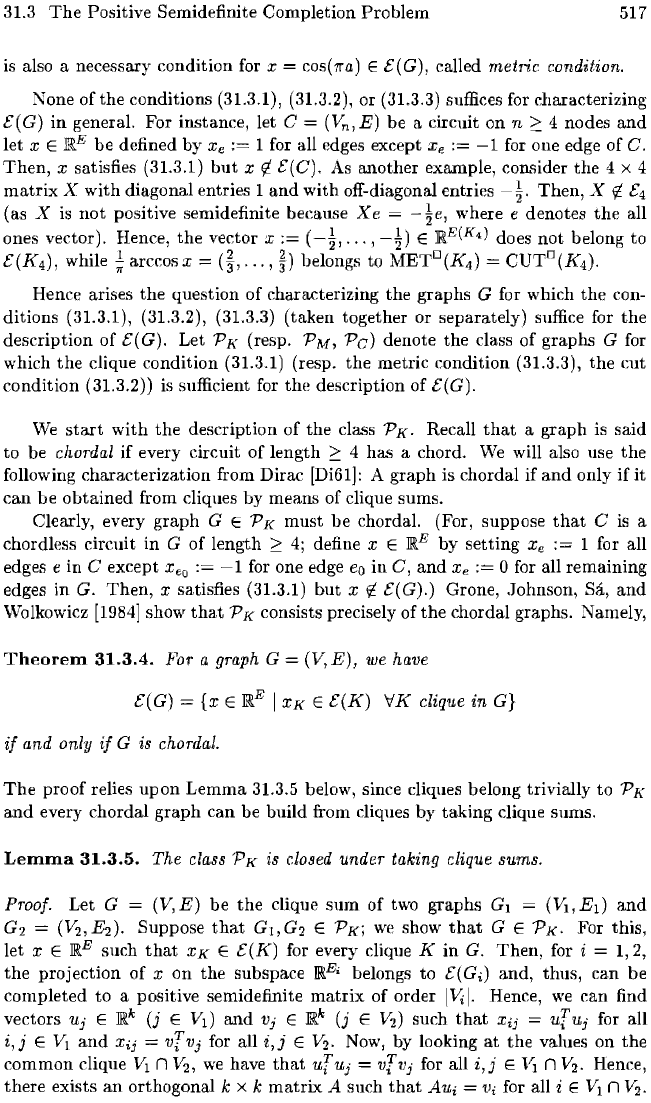
31.3
The
Positive Semidefinite Completion Problem
517
is also a necessary condition for
x
cos(1l"a)
E
£(G),
called
metric
condition.
Xone of the conditions (31.3.1), (31.3.2), or (31.3.3) suffices for characterizing
£ (G)
in
general. For instance, let e (Vn,
E)
be a circuit on n
:::::
4 nodes
and
let x E
TIRE
be defined by
Xe
1 for all edges except
Xc
:=
-1
for one edge
of
e.
Then,
x satisfies (31.3.1)
but
x
r:f.
£(e).
As
another example, consider the 4 x 4
matrix
X with diagonal entries 1
and
with off-diagonal entries -
~.
Then, X
r:f.
£4
(as X
is
not
positive semidefinite because
Xe
=
-~e,
where e denotes
the
all
ones vector). Hence, the vector
x
...
,-~)
E
]RE(K.)
does not belong to
£(K
4
),
while
~
arccos x
...
,~)
belongs to METD(K4) =
CUT
O
(K
4
).
Hence arises the question of characterizing the graphs G for which
the
con-
ditions (31.3.1), (31.3.2), (31.3.3) (taken together or separately) suffice for
the
description of
£(G).
Let
PK
(resp.
PM,
Pc)
denote the class of graphs G for
which the clique condition (31.3.1) (resp. the metric condition (31.3.3),
the
cut
condition (31.3.2» is sufficient
for
the
description of
£(G).
We
start
with the description of the class P
K
.
Recall
that
a graph is said
to be
chordal if every circuit of length
:::::
4 has a chord.
We
will also use
the
following characterization from Dirac
[Di61]:
A graph is chordal if
and
only
ifit
can
be
obtained from cliques by means of clique sums.
Clearly, every graph G
E P
K
must
be
chordal. (For, suppose
that
e
is
a
chordless circuit
in
G
of
length:::::
4;
define x E ]RE by setting
Xe
:=
1 for all
edges
e in e except xeo
:=
-1
for one edge
eo
in
e,
and
Xe
:=
0 for all remaining
edges
in
G.
Then,
x satisfies (31.3.1) but x
r:f.
£(G).)
Grone, Johnson, Sa,
and
Wolkowicz
[1984]
show
that
PK
consists precisely of the chordal graphs. Namely,
TheoreIn
31.3.4.
For a graph G =
(V,E),
we have
£(G)
=
{x
E
Jill.E
I
XK
E
£(K)
VK
clique
in
G}
if
and
only
if
G is chordal.
The
proof relies
upon
Lemma
31.3.5 below, since cliques belong trivially to
PK
and
every chordal graph
can
be build from cliques
by
taking clique sums.
LeInIna
31.3.5.
The
class
PK
is closed
under
taking clique
sums.
Proof. Let G = (V,
E)
be
the
clique
sum
of two graphs G
1
(VI,
E
1
)
and
G
2
= (V21 E2)' Suppose
that
G
1
,
G
2
E
PKi
we
show
that
G E
PK.
For this,
let
x E
.rn:
E
such
that
XK
E
£(K)
for every clique K in G. Then, for i =
1,2,
the projection
of
x on the subspace
]REi
belongs
to
£(Gi)
and, thus,
can
be
completed to a positive semidefinite
matrix
of
order
IViI.
we
can
find
vectors
Uj
E
.rn:k
(j
E VI)
and
Vj
E
Jill.k
(j
E V
2
)
such
that
Xij
u;
Uj
for all
i, j E
VI
and
Xij
=
v;
Vj
for all
i,j
E V
2
•
Now,
by looking
at
the values on
the
common clique
VI
n V
21
we
have
that
u;
Uj
v;
Vj
for all
i,j
E V
l
n V
2
•
Hence,
there exists
an
orthogonal k x k
matrix
A such
that
Au;
Vi
for all i E
VI
n V
2
•
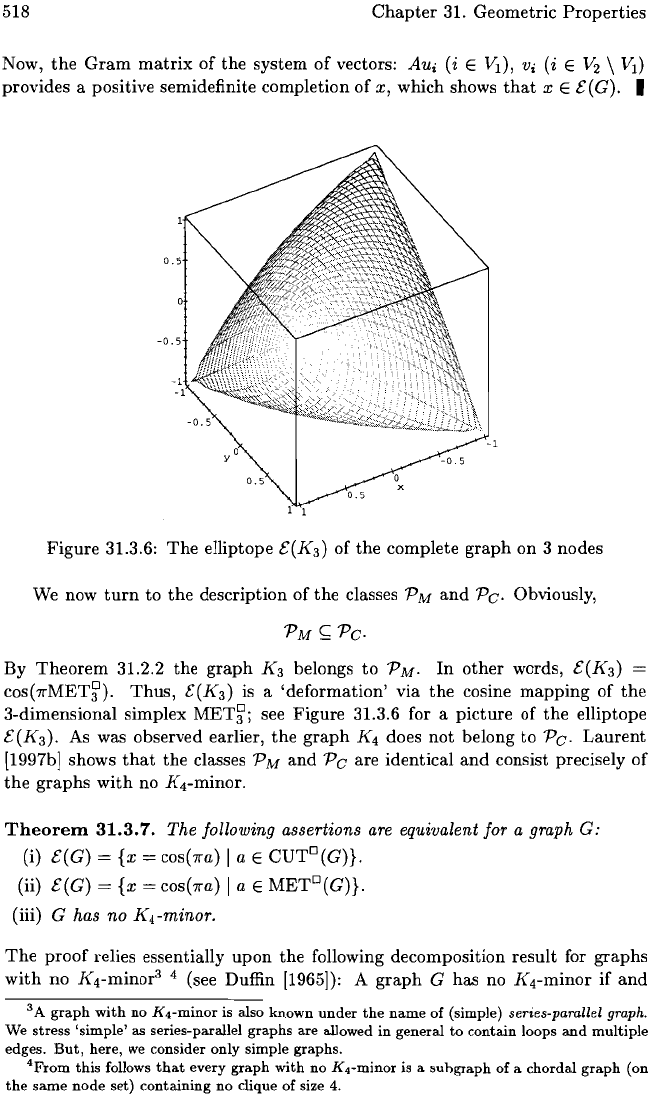
518
Chapter
31. Geometric
Properties
Now,
the
Gram
matrix
of
the
system
of
vectors:
AUi
(i E VI),
Vi
(i E V
2
\
VI)
provides a positive semidefinite completion
of
x,
which shows
that
x E E(G). I
Figure
31.3.6:
The
elliptope
E(K3)
of
the
complete
graph
on
3 nodes
We now
turn
to
the
description
of
the
classes PM
and
Pc. Obviously,
By
Theorem
31.2.2
the
graph
K3 belongs
to
PM.
In
other
words,
E(K3)
=
cos(7rMET~).
Thus,
E(K3)
is
a
'deformation'
via
the
cosine
mapping
of
the
3-dimensional simplex
MET~j
see
Figure
31.3.6 for a
picture
of
the
elliptope
E(K3).
As was observed earlier,
the
graph
K4 does
not
belong
to
Pc.
Laurent
[1997b] shows
that
the
classes PM
and
Pc
are identical
and
consist precisely
of
the
graphs
with
no K
4
-minor.
Theorem
31.3.7.
The
following assertions are equivalent
for
a graph
G:
(i) E(G) =
{x
= cos(7ra) I a E CUTD(G)}.
(ii)
E(G) =
{x
= cos(7ra) I a E METD(G)}.
(iii) G
has
no
K4
-minor.
The
proof
relies essentially
upon
the
following decomposition result for graphs
with
no K
4
-minor
3
4 (see Duffin [1965]): A
graph
G has no
K4-minor
if
and
3 A
graph
with
no
K,-minor
is
also known
under
the
name
of (simple) series-parallel graph.
We
stress
'simple'
as series-parallel
graphs
are allowed in general
to
contain
loops
and
multiple
edges.
But,
here,
we
consider only simple graphs.
'From
this
follows
that
every
graph
with
no
K,-minor
is a
subgraph
of a
chordal
graph
(on
the
same
node
set)
containing
no
clique of size 4.
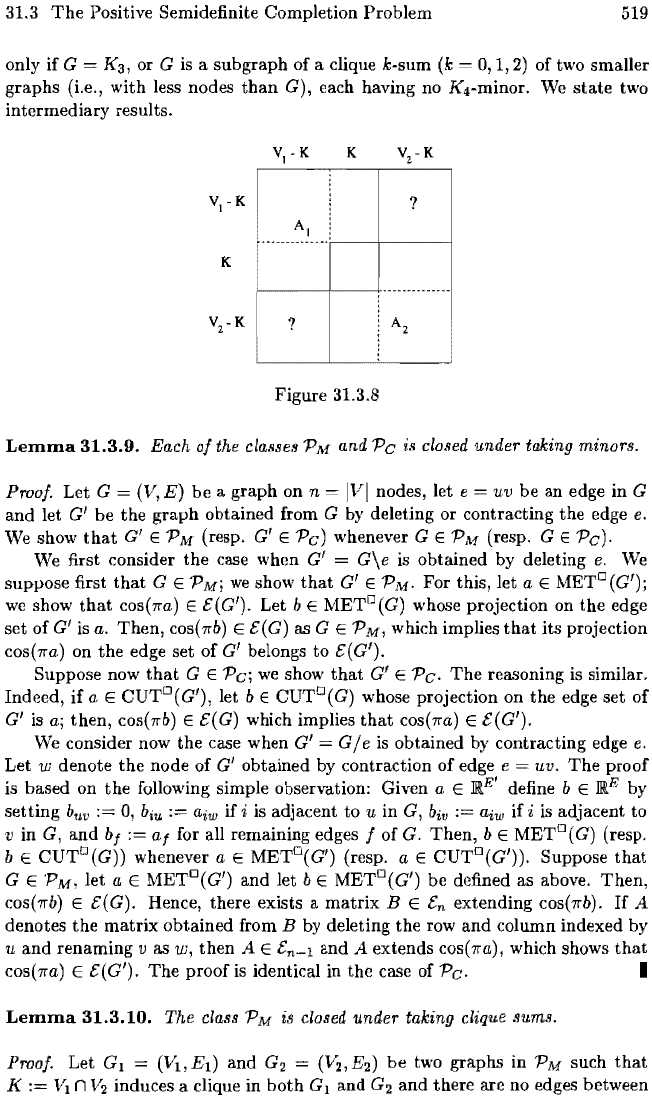
31.3
The
Positive Semidefinite Completion Problem
519
only if G = K
3
,
or G
is
a subgraph
of
a clique k-sum (k
0,1,2)
of two smaller
graphs (Le., with less nodes
than
G), each having no K4-minor.
We
state
two
intermediary results.
V K
I
K
'2
K
?
AI
K
?
A2
Figure 31.3.8
Lemma
31.3.9.
Each
0/
the classes PM
and
Pc
is
cla.~ed
under
taking
minors.
Proof. Let G (V,
E)
be a graph on n
IVI
nodes, let e
uv
be
an
edge in G
and let
G'
be the graph obtained from G by deleting or contracting the edge
e.
We
show
that
G'
E PM (resp.
G'
E
Pc)
whenever G E
PM
(resp. G E
Pc).
We
first consider
the
case when
G'
=
G\e
is obtained by deleting
e.
We
suppose first
that
G E PM;
we
show
that
G'
E PM. For this, let a E METD(G');
we
show
that
cos(rra) E e(G'). Let
bE
METD(G) whose projection on
the
edge
set of
G'
is
a.
Then, cos(
1rb)
E
e(
G) as G E PM, which implies
that
its projection
cos(1ra)
on the edge set of
G'
belongs
to
e(G').
Suppose now
that
G E
Pc;
we
show
that
G' E
Pc.
The
reasoning
is
similar.
Indeed,
if
a E CUTD(G'), let
bE
CUTO(G) whose projection on the edge set
of
G'
is
a;
then,
cos(1rb)
E e(G) which implies
that
cos(1ra)
E e(G').
We
consider now the case when
G'
=
G/e
is
obtained
by
contracting edge
e.
Let w denote the node of
G'
obtained
by
contraction of edge e = uv.
The
proof
is based on
the
following simple observation: Given a
ERE'
define b E RE by
setting
b
uv
0,
b
iu
:=
aiw if i
is
adjacent to u in G, biv
:=
aiw
if i
is
adjacent to
v in G, and
bf
:=
af
for all remaining edges / of G. Then, b E METD(G) (resp.
bE
CUTD(G)) whenever a E METD(G') (resp. a E CUTD(G')). Suppose
that
G E PM, let a E METD(G') and let
bE
METD(G') be defined as above. Then,
cos(1rb)
E e(G). Hence, there exists a matrix
BEen
extending
cos(1rb).
If
A
denotes
the
matrix obtained from B
by
deleting the row and column indexed by
u and renaming
vas
w,
then
A E
en-l
and A extends
cos(1ra),
which shows
that
cos(1ra)
E e(G').
The
proof
is
identical in the case of
Pc.
I
Lemma
31.3.10.
The
class PM is closed
under
taking clique sums.
Proof.
Let G
I
=
(Vl,El)
and G
2
(V
2
,E
2
)
be two graphs in PM such
that
K
:=
VI
n V
2
induces a clique in
both
G
I
and G
2
and there are no edges between
